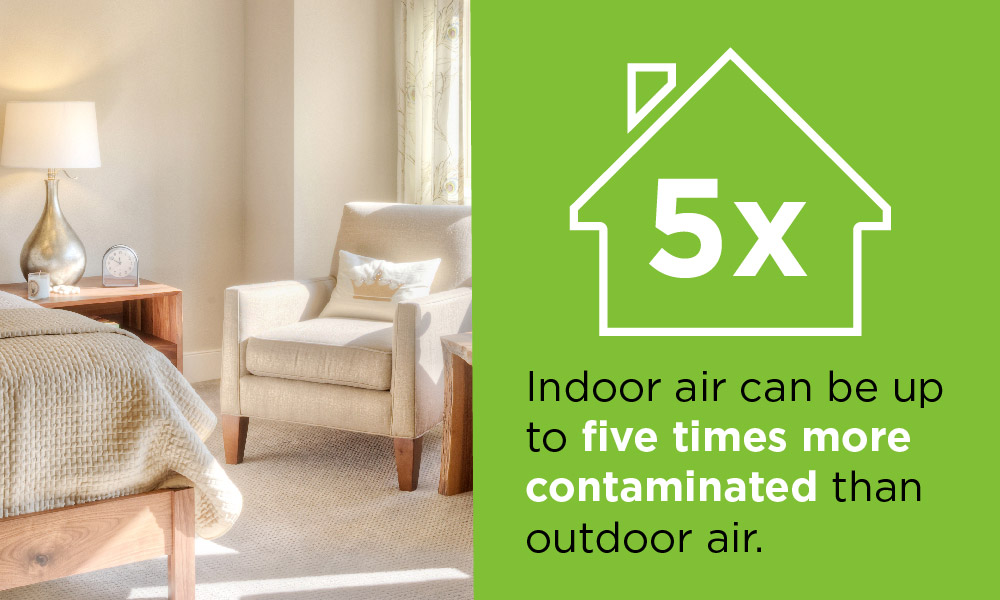Indoor Air Quality – A Guide Toward Improving
Indoor air quality plays a vital role in our health and quality of life. According to the Environmental Protection Agency, Americans spend on average 90% of their lives indoors where concentrations of some pollutants are 2-5 times higher than they in the great outdoors. People who are most susceptible to the adverse effects of poor air quality (the elderly, the very young, and those with respiratory disease) tend to spend more time indoors than others. With these facts in mind, it is easy to see why indoor air quality matters.
Impacts of Poor Air Quality
Poor indoor air quality is the source of many health problems, from irritation of the eyes, nose, and throat to headaches, dizziness, and fatigue. It is known to cause asthma attacks (especially in children) and is associated with adult-onset asthma, respiratory disease, cardiovascular disease, and cancer.
In workplaces and schools, these impacts often result in poor concentration, reduced productivity, increases in absenteeism, and added healthcare costs.
Improving Indoor Air Quality With Proper Cleaning
There are many pollutants that cause foul air in indoor environments from dust and pet dander to insecticides, paints, and even cleaning supplies. Many of the pollutants found indoors originate outside and are inadvertently brought into a building on the shoes and clothing of occupants. One of the most important steps you can take to improve indoor air quality is to use proper cleaning techniques.
Cleaning Guide
Using entryway mats
Using entryway mats (both indoors and out) to help trap dirt, dust, and other pollutants that are hitching a ride on peoples’ shoes is a great start. Of course, in order for the mats to remain effective, they need to be cleaned regularly.
Use cleaning chemicals properly
Many cleaning chemicals contain pollutants (including volatile organic compounds) which are released into the air when sprayed. You can reduce the impact these chemicals have on indoor air quality by adjusting spray bottles to stream rather than mist and by spraying on a cleaning cloth rather than directly on the surface to be cleaned.
Keep restrooms, kitchens, and breakrooms clean
These areas are often home to food particles, spills, organic pollutants, and standing water, all of which can produce molds and mildew that adversely affect indoor air quality. Food particles and spills when left unattended can introduce pests to your indoor environment which can lead to increased use of pesticides.
Use microfiber cloths and mops
Using microfiber cloths and mops can also help to improve indoor air quality. Traditional mops and cleaning cloths have a tendency to spread dirt around, leaving it to become airborne once it dries. Microfiber traps the dirt and removes it. Be sure that your cleaning equipment is properly cleaned after each use.
HEPA filters
Vacuum regularly with a HEPA filter-equipped vacuum. Textiles like carpets and upholstery trap dirt, dust, and bacteria. In fact, your carpet can hold up to 200,000 bacteria per square inch! Frequent vacuuming of rugs, carpets, and upholstery removes much of this debris and HEPA filtering ensures that it is not re-released into the air.
Green cleaning
Use ‘green’ cleaning products and techniques. Green cleaning products are less toxic than traditional cleaning chemicals and most are free of volatile chemical compounds. Switching to green cleaning chemicals and green cleaning procedures can have a profound impact on indoor air quality. In a study performed by the EPA at a Washington DC elementary school switching to green cleaning chemicals and procedures, reduced airborne dust inside the building by 52%, volatile organic chemical (VOC) concentrations decreased by 49%, bacteria decreased by 40%, and fungi colony-forming units decreased by 61%.
Need Help With Your Indoor Air Quality?
Need help developing a cleaning program to improve indoor air quality in your home or workplace? Complete Care Maintenance can help you to develop an effective policy for controlling indoor air pollution, which can help improve the overall health of employees and family members, improve productivity, and reduce healthcare costs.




